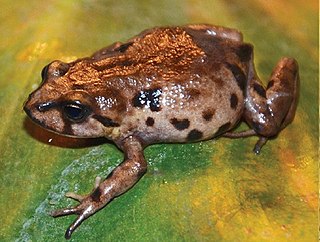
Phrynopus is a genus of frogs of the family Strabomantidae. Their common name is Andes frogs. They are endemic to Peru and inhabit the upper humid montane forest and supra-treeline grassland in the Cordillera Oriental, with one record from the Peruvian Cordillera Occidental.
Rhinella nesiotes is a species of toad in the family Bufonidae that is endemic to Peru. Its natural habitats are subtropical or tropical moist lowland forests and subtropical or tropical moist montane forests. It is threatened by habitat loss.
The Philippine toad is a species of toad in the family Bufonidae. It is endemic to the Philippines. Its natural habitats are subtropical or tropical dry forest, subtropical or tropical moist lowland forest, subtropical or tropical swamps, subtropical or tropical moist montane forest, subtropical or tropical moist shrubland, intermittent rivers, swamps, freshwater lakes, intermittent freshwater lakes, freshwater marshes, intermittent freshwater marshes, intertidal marches, arable land, plantations, rural gardens, urban areas, water storage areas, ponds, aquaculture ponds, and seasonally flooded agricultural land.

The common reed frog is a species of tree frogs in the family Hyperoliidae found in Burundi, the Democratic Republic of the Congo, Ethiopia, Kenya, Rwanda, Sudan, Tanzania, and Uganda, and possibly the Central African Republic, Chad, and Eritrea. Its natural habitats are subtropical or tropical dry forest, subtropical or tropical moist lowland forest, subtropical or tropical moist montane forest, dry savanna, moist savanna, subtropical or tropical dry shrubland, subtropical or tropical moist shrubland, subtropical or tropical seasonally wet or flooded lowland grassland, subtropical or tropical high-altitude grassland, rivers, swamps, freshwater lakes, intermittent freshwater lakes, freshwater marshes, intermittent freshwater marshes, freshwater springs, arable land, pastureland, rural gardens, urban areas, heavily degraded former forests, water storage areas, ponds, irrigated land, seasonally flooded agricultural land, and canals and ditches.
Ichthyophis weberi, the Malatgan River caecilian, is a species of amphibian in the family Ichthyophiidae endemic to the Philippines. Its natural habitats are subtropical or tropical moist lowland forests, subtropical or tropical moist montane forests, rivers, intermittent rivers, plantations, rural gardens, heavily degraded former forests, irrigated land, and seasonally flooded agricultural land.

Ichthyophis paucisulcus, the Siantar caecilian, is a species of amphibian in the family Ichthyophiidae found in Indonesia and Singapore. Its natural habitats are subtropical or tropical moist lowland forests, subtropical or tropical swamps, rivers, intermittent rivers, plantations, rural gardens, heavily degraded former forests, seasonally flooded agricultural land, and canals and ditches.
Phrynopus bracki is a species of frog in the family Strabomantidae. It is endemic to Peru and only known from its type locality in the Cordillera Yanachaga, Pasco Region. The specific name bracki honors Antonio Brack, agronomist and ecologist who was instrumental for the establishment of the Yanachaga–Chemillén National Park. Common name Brack's Andes frog, has been coined for it.
Phrynopus bufoides is a species of frog in the family Strabomantidae. It is endemic to Peru. Its natural habitat is subtropical or tropical high-altitude shrubland.
Phrynopus heimorum is a species of frog in the family Strabomantidae. It is endemic to Peru. Its natural habitats are subtropical or tropical moist montane forest and subtropical or tropical high-altitude shrubland. It is threatened by habitat loss.
Phrynopus horstpauli is a species of frog in the family Strabomantidae. It is endemic to Peru. Its natural habitats are subtropical or tropical moist montane forest, subtropical or tropical high-altitude shrubland, pastureland, and rural gardens. It is threatened by habitat loss.

Phrynopus juninensis is a species of frog in the family Strabomantidae. It is endemic to Peru and only known from Cascas near Huasihuasi, Department of Junín. Records from Department of Pasco probably belong to another species. Common name Junin Andes frog has been proposed for this species.
Phrynopus montium is a species of frog in the family Strabomantidae. It is endemic to Peru and only known from two localities near Cascas in the Junín Region: "Cascas near Huasahuasi", the imprecisely known type locality where the types were collected in 1936, and south of Hacienda Cascas, where it was found in 2014. Records from the PascoPasco and Huánuco Regions refer to Phrynopus kotosh and Phrynopus oblivius, respectively. Common name Cascas Andes frog has been coined for this species.
Phrynopus paucari is a species of frog in the family Strabomantidae. It is endemic to Peru. Its natural habitat is subtropical or tropical high-altitude grassland.
Phrynopus peruanus is a species of frog in the family Strabomantidae. It is endemic to Peru. Its natural habitat is subtropical or tropical moist montane forests.
Phrynopus pesantesi is a species of frog in the family Strabomantidae. It is endemic to Peru. Its natural habitat is subtropical or tropical high-altitude grassland.
The Giant Visayan frog is a species of frog in the family Dicroglossidae. It is endemic to the Philippines, and is known from Masbate, Cebu, Negros, Guimaras, Panay, and Siquijor islands.

The Mascarene grass frog, or Mascarene ridged frog, is a species of frog in the family Ptychadenidae. It is found in sub-Saharan Africa, Madagascar, and Mauritius.
Phrynopus auriculatus is a species of frog in the family Strabomantidae. It is endemic to Peru and only known from its type locality near Oxapampa, Pasco, at 2,600 m (8,500 ft) asl. It inhabits humid montane forest.
Phrynopus tribulosus is a species of frog in the family Strabomantidae. It is endemic to Peru and only known from its type locality near Oxapampa at 2,600 m (8,500 ft) asl, and from Santa Bárbara, in the Huancabamba District, Oxapampa, Pasco Region. It inhabits humid montane forests where individuals could be found deep within a mossy bank by day.
Phrynopus tautzorum is a species of frog in the family Strabomantidae. It is endemic to Peru and only known from its type locality near Maraypata, in the Ambo Province, Huánuco Region, at 3,770 m (12,370 ft) asl. It lives in the puna grassland ecoregion. Individuals have found under stones on moist underground. Livestock farming occurred at the type locality, but its impact on this species is unknown.





